
- Call: +1-630-344-9840
- Email: [email protected]


High School Grades (9 - 12)
High School (9 - 12) students are mastering the reading and writing skills that will serve them from their first Honors course to their final college application. We’ll guide them through even the most stressful exams while supporting their individual emotional and intellectual growth.

Seasonal Workshops

Grammar & Essays
Grades (6 - 9).
Do you know the difference between “Let’s eat, Grandma” and “Let’s eat Grandma”? Stumped? In the former, you have a nice family dinner. In the latter, you have the makings of a particularly dark Grimms’ fairytale. Your child can avoid such tragic misunderstandings while improving their academic and professional writing with our Grammar & Essays Workshop.

College Admission Essays
“Why do you want to go to this college?” “What will you accomplish with this major?” “Why should we choose you?” Between managing a rigorous course load, dozens of extracurriculars, and college applications, the start of senior year is one of the most stressful times of a young adult's life. The application process stretches even the most organized student’s project management skills and demands exhaustive self-reflection. However, there's no need to panic.
Test Prep Workshops

Grades (8 - 12)
Is your college-bound student fretting about the PSAT/NMSQT or SAT? Could they benefit from some guidance and structured practice to relieve their stress? LTWN’s SAT Prep Workshop will help your child gain the poise, pacing, and precision needed to achieve top scores. They will learn how to crush the test instead of letting the test crush them!

Grades (7 - 8)
Is your middle schooler feeling anxious and unprepared to take PSAT 8? LTWN’s PSAT Prep Workshop will boost your child’s confidence by honing their test-taking skills, preparing them for success on this and other standardized tests. Not only will they improve their scores, but they’ll develop the critical reasoning and reading skills that will boost their performance throughout high school.

Frequently Asked Questions
%20copy%203.png)
+1 630-344-9840
%20copy.png)
[email protected]

Fall, Winter & Spring Hours
- Mon, Tue, Wed, Thu : 4:00 pm - 8:00 pm CST
- Sat: 8:00 am - 4:00 pm CST
Summer Hours
- Mon, Tue, Wed, Thu : 9:00 am - 12:00 pm CST
- Google Reviews
- Enrollment Agreement
- Terms Of Service
- Privacy Policy
Sign up to get the latest updates and more …
Unsubscribed successfully
- Top Courses
- Online Degrees
- Find your New Career
- Join for Free
Learn Essential Writing Skills
The Writing courses listed cover various aspects including creative writing, business communication, journalism, and literature. These programs are structured to enhance your writing skills and understanding, preparing you for professional success in multiple writing-focused fields.
The language used throughout the course, in both instruction and assessments.
Choose the Writing Course That Aligns Best With Your Educational Goals

Michigan State University
Write Your First Novel
Skills you'll gain : Storytelling
(305 reviews)
Beginner · Course · 3 - 6 Months

Wesleyan University
Creative Writing
Skills you'll gain : Creativity, Human Learning, Storytelling, Writing
(5.9K reviews)
Beginner · Specialization · 3 - 6 Months

University of Michigan
Good with Words: Writing and Editing
Skills you'll gain : Writing, Communication, Leadership and Management, Professional Development, Critical Thinking, Creativity, Planning, Resilience
(2.4K reviews)

University of California, Irvine
Academic English: Writing
Skills you'll gain : Writing
(22K reviews)

Lund University
Writing in English at University
(595 reviews)
Beginner · Course · 1 - 4 Weeks

Stanford University
Writing in the Sciences
(8.4K reviews)
Beginner · Course · 1 - 3 Months

Script Writing: Write a Pilot Episode for a TV or Web Series (Project-Centered Course)
(740 reviews)
Mixed · Course · 1 - 3 Months

Duke University
English Composition I
(1.1K reviews)

University of Colorado Boulder
Business Writing
Skills you'll gain : Communication, Writing, Business Communication, Critical Thinking, Professional Development, Natural Language Processing, Business Development, Creativity, Reinforcement Learning, Strategy
(4.6K reviews)

Write A Feature Length Screenplay For Film Or Television
(206 reviews)

Writing and Editing: Word Choice and Word Order
Skills you'll gain : Writing, Creativity, Resilience
(1.9K reviews)

Grammar and Punctuation
(19K reviews)
Mixed · Course · 1 - 4 Weeks
Searches related to writing
In summary, here are 10 of our most popular writing courses.
- Write Your First Novel : Michigan State University
- Creative Writing : Wesleyan University
- Good with Words: Writing and Editing : University of Michigan
- Academic English: Writing : University of California, Irvine
- Writing in English at University : Lund University
- Writing in the Sciences : Stanford University
- Script Writing: Write a Pilot Episode for a TV or Web Series (Project-Centered Course) : Michigan State University
- English Composition I : Duke University
- Business Writing : University of Colorado Boulder
- Write A Feature Length Screenplay For Film Or Television : Michigan State University
Skills you can learn in Business Essentials
Frequently asked questions about writing, what are the best free writing courses .
If you're looking for the best free writing courses on the web, then look no further! Coursera has you covered with a wide variety of writing classes from Novel Writing to Journalism to Scientific Writing to English Composition to Poetry Workshop . There is something for everyone looking to hone their writing skills.
What are the best writing courses for beginners?
If you're just getting started with writing and looking for a comprehensive suite of courses, Coursera offers great options. The Writing for Business course provides a good foundation for clear and effective business writing. For those interested in honing their editing skills, Writing, Editing, & Words and Writing, Editing, & Structure cover writing process, drafting and revision for maximum clarity. Writing Your World and Writing About Ourselves focus on creative writing development with personal and fictional stories.
What are the best advanced writing courses?
For those looking to take their writing skills to the next level, Coursera offers excellent advanced writing courses. The Just Reading and Writing English course is a great resource for anyone wanting to brush up on their reading and writing skills. Additionally, for those looking for more in-depth grammar instruction, the English: Writing and Grammar: Adverb Clauses , English: Writing and Grammar: Noun Clauses , and English: Writing and Grammar: Adjective Clauses classes provide comprehensive instruction. Finally, Copy of Glasscock: Writing: Grammar & Style delves into the art of editing and revising, allowing users to learn the more nuanced aspects of writing.
Why is it important to learn to write?
Alongside verbal communication and body language, writing is one of the most essential forms of interpersonal communication. In the workplace, strong writing skills allow you to send persuasive emails to your boss or clarify complicated instructions with coworkers. In your personal life, writing allows you to keep in touch with friends and family members via texts, social media posts, or traditional letters.
Not all writing is intended for interpersonal communication. Sometimes you simply need to write to organize your thoughts or record information for later use. Writing things down by hand can also improve your memory retention and understanding of a subject.
What are typical careers that use writing?
Writing is an essential skill if you want to pursue a career in a field such as copywriting, journalism, technical writing, or scriptwriting. Copywriters use their writing to persuade audiences to try a service, buy a product, or participate in an event. Journalists write about current events, and their work can help people make informed daily decisions. Technical writers break down complex processes into more concise and easy-to-understand text. Scriptwriters, novelists, and poets produce artistic works that entertain, inspire, and inform audiences. Artistic works can also challenge viewers to explore a new perspective.
Many other career paths are also writing-intensive. For example, public relations specialists need to constantly communicate with the press and public in media releases, and scientific researchers often have to record and share their findings in academic papers.
How can online courses on Coursera help me learn about writing?
Online courses on Coursera will help you learn or brush up on the basics of spelling, grammar, and sentence structure. Mastering these elements of writing gives you a foundation to build on. Courses in storytelling take your education a step further, offering lessons on crafting coherent and creative narratives. Other courses focus on more specific areas of interest, such as technical writing, poetry, journalism, and personal essays. You can take the lessons at your own pace and work on the lessons from anywhere that has internet access.
What are the benefits of taking an online Writing course?
Online Writing courses offer a convenient and flexible way to enhance your knowledge or learn new Writing skills. Choose from a wide range of Writing courses offered by top universities and industry leaders tailored to various skill levels.
What Writing courses are best for training and upskilling employees or the workforce?
When looking to enhance your workforce's skills in Writing, it's crucial to select a course that aligns with their current abilities and learning objectives. Our Skills Dashboard is an invaluable tool for identifying skill gaps and choosing the most appropriate course for effective upskilling. For a comprehensive understanding of how our courses can benefit your employees, explore the enterprise solutions we offer. Discover more about our tailored programs at Coursera for Business here .
Other topics to explore

Learn To Write Now LLC
Reading and writing in naperville, il, usa.
At Learn to Write Now, our aim is to unlock reading and writing potential of every student and help them achieve academic success. Our proud workshops help students develop their imagination, problem solving techniques, communication skills and enjoy the pleasure of reading and writing.
Company Overview:
Since 2008, Learn to Write Now (LTWN) is helping students to write, learn and succeed in their life. We are an online ELA after school program for K-12 grade students, designed to provide them a platform where they become proficient in all areas of literacy and achieve the highest level of excellence. We accomplish this by offering intuitive, engaging, efficient, and effective workshops, which are created by our team of expert teachers. It combines classroom instructions, homework and timely feedback to maximize learning outcomes. Our offered courses for kindergarten, elementary and high school students include writers’ workshop, readers’ workshop, grammar and essay workshop, SAT/PSAT prep workshop, creative writing workshop, speech and debate workshop and more. We also offer LTWN 360, a comprehensive year-round program providing overall proficiency in writing, reading, grammar, vocabulary, essays, speech & debate, and test prep.
Business Name:Learn To Write Now LLC
Contact Person:Aruna Davis (Founder and CEO)
Address –2623 Deering Bay Dr
City –Naperville
Country –USA
Zip code/ PIN code –60564
Phone Number –630 344 9840
Company Email ID – [email protected]
Website – https://www.learntowritenow.com/
Available Slots
Teacher details, customer details.

If you’re here, you want to learn to write—whether that’s poetry, fiction, nonfiction, or something in-between. Learning to write is a process, one that requires consistent hard work and determination—and perhaps some magic! But, as with any other skill, it’s important to work hard on the right thing.
Instead of providing a list of pointers on how to learn to write for general purposes, this guide will offer eight key tips that will help you learn how to write creatively.
Learn to Write: Contents
1. How to Learn to Write: Take a writing class
2. how to learn to write: read, 3. how to learn to write: set an intention, 4. how to learn to write: start, 5. how to learn to write: use writing exercises, 6. how to learn to write: understand the writing process, 7. how to learn to write: understand yourself., 8. how to learn to write: seek resources, learn to write with 8 simple tips.
If you’re learning how to write (or want to get started!), these 8 tips will set you up for success.
A writing class is a great place for writers to begin—it’s also where this writer first learned to write! The writing class is great for all kinds of learners as it provides a range of learning formats, including lectures, discussions, and workshops. The most valuable aspect of taking a writing course, however, is that it provides a supportive environment for writers.
In my experience, taking classes helped me to get over my fear of the blank page by showing me multiple approaches to beginning a poem, short story, or essay. Having the structure of a writing course was particularly helpful, as it kept me accountable to my goals.
Writers.com has a great roster of creative writing courses . But, before you sign up for a writing class, I would suggest that you do some research. Some questions to ask include: who’s teaching? Are there prerequisites? What is the class size? If you’re looking for an online writing class, this guide offers some great tips!
Reading is bread and butter for a writer no matter what stage of their career they’re at. Reading is how we both discover what we gravitate to and, inevitably, learn to write. Writers read not just for fun, but also with a critical lens, noting techniques that we can apply to our own work. Indeed, reading as a writer is a skill that’s very different from reading as a reader, as a student, or even as a scholar. Check out this article to learn more about reading as a writer.
For a more comprehensive guide, I recommend Francine Prose’s Reading Like a Writer: a Guide for People who Love Books and for those who Want to Write Them .
Before you start learning to write, take a moment to think about these questions: in an ideal world, what do you want to write? Who would you like to write for? If you’re unsure how to answer these questions, I recommend first listing a few books and/or authors that inspire you. What do these books have in common?
The objective of setting an intention is not to pose an “endpoint” for yourself. Rather, it is to provide yourself with a direction with which to begin . Let’s say that I am interested in writing high-fantasy books like The Lord of the Rings . Although there’s nothing wrong with setting that as my goal and making a step-by-step plan to achieve that goal, having a specified endpoint, in my experience, often becomes debilitating for my writing process. For one, I may become discouraged when I find that my first draft has nothing in common with Tolkien’s epic. Or, I may find that realism comes more naturally to me and feel frustrated that I am not following the path I had planned to take.
In contrast, approaching The Lord of the Rings as a direction (rather than as a goal) looks more like amassing a set of skills. For example, I might begin by practicing the technique of worldbuilding, or the creation of a fantasy world. I might then decide to try my hand at crafting memorable characters . This way, even if your tastes or goals evolve in the writing process (and they will!), you will have developed a skillset that is transferable to other forms of writing.
Every writer has a different starting point. For Louise Erdrich, it is often the voice of a character that helps her begin her novel. For others, it may be a narrative situation or personal experience. It is a good idea to experiment with different approaches to beginning. This allows you to not only learn what helps you write, but also challenge yourself as a writer.
When you’re just starting to learn how to write, expect that what you write won’t come out the way you want it. This is natural – all writers, even experienced ones, undergo this process. The important thing is to start and know that your writing does not have to be perfect at first try. The beauty of writing is that you don’t have to show it to anyone until you want to.
With that said, I suggest that you keep all of your writing, even if you don’t like it. You never know when you’ll find it interesting again!
When the possibilities are endless, it can be difficult to begin. If you find yourself wavering, I recommend using a writing exercise to help jumpstart your process and learn how to write. Even if you don’t end up using what you generated, writing exercises are a great way to learn to write. To begin, check out this article !
If you’re in need of more prompts (and a supportive community!), our Facebook group is also a great resource.
To learn how to write, it is essential to understand the nature of the writing process, which is often not as straightforward or linear as you think. Make no mistake: even accomplished writers go through multiple drafts, as the writer Anne Lamott shares in Bird by Bird: Some Instructions on Writing and Life . The good news, however, is that there is absolutely no pressure on your first draft—in fact, Lamott actively strives to write a “shitty first draft.”
Often, a piece of writing goes through massive changes from first draft to last. It is hard work, but the bright side of this is that you do not need to plan out the details of your book before you start writing. As the novelist E. L. Doctorow once said, “ Writing a novel is like driving a car at night. You can see only as far as your headlights, but you can make the whole trip that way.”
In addition to working actively on your draft, it’s important to schedule in time for your draft to “rest,” too. Stephen King, for example, shares in On Writing: a Memoir of the Craft that he shuts his first draft up in his drawer for at least six weeks before revisiting it. This rest time, King explains, helps to create distance and allows the writer to assess their own writing in a more objective manner.
Of the eight tips in this article, this is perhaps the most important point. By “understanding yourself,” I don’t mean “discovering” your “true self” or “psyche.” Instead, I mean understanding your habits, strengths, likes, and dislikes. In my experience, the most challenging part of learning to write is starting. Understanding what helps you to write on a practical level can alleviate this pressure and create the conditions you need to help your creative juices flow.
To begin, here is a list of things you might want to experiment with:
- Writing requirements: Are you a pen and paper writer? Do you type? Do you do both? If you do both, do you write your first draft and type the second, or vice versa?
- Physical space: Do you need to have your own room—where you will have no distractions—like Zadie Smith, or can you write at the dining table with children running around you, like Suzan Lori-Parks? Do you write best when you have a window you can look out of, or do you need to minimize distractions in your environment?
- Daily schedules: When are you free and most productive? For Toni Morrison, who had young children when she first started writing, it was the time before sunrise. For H. P. Lovecraft, it was at night.
- Routines: Although many say that writers have to write in the morning every single day, the best writing schedule, in my opinion, is one that makes sense for your own life. Do note that even if you have an established writing routine, it may change according to life circumstances. It’s important to be flexible and willing to try new approaches when you feel like your established routine no longer works.
- Writerly tendencies: What genre captivates you, and what genre comes most intuitively to you? Note that these may not necessarily be the same! Personally, I started writing with the intention of writing fiction, but have since written more poetry and nonfiction. I’d encourage you to learn how to write in all three genres—what you find may surprise you!
While writing is mostly a solitary activity, don’t underestimate the power of having a community! A writing group keeps you accountable, teaches you how to learn to write professionally, and provides a safe space for you to workshop an early draft. An authentic writing community, however, can be difficult to come by outside of a writing course.
For more tips on learning to write, I recommend the following books:
- On Writing: a Memoir of the Craft by Stephen King
- Bird by Bird: Some Instructions on Writing and Life by Anne Lamott
- What I Talk About When I Talk About Running by Haruki Murakami
- Recollections of My Nonexistence by Rebecca Solnit
- The Writing Life by Annie Dillard
Learn How to Write at Writers.com
Learning to write can seem intimidating, but it’s important to remember that all writers started where you are: at the beginning. Remember to take things slow—habits are built gradually and consistently—as you build your writing routine into your everyday life.
For more resources on learning how to write, check out our weekly writing tips , as well as our upcoming course calendar .
Okay, I’m in. Writing has been the bane of my existence for six decades. Hopefully, “Writers.com” really can teach an OLD dog new tricks. Thanks for the excellent web site. Cheers!
V/r, NoNegativeWaves70
Hi,my name is Mercy. Stumbled on this site while searching for how to write. Although I have written short plays and poems,yet to be published, but I really want to go into writing, fiction and nonfiction inclusive. And am eager to learn. Thanks
Hi, I am Martin. I stumbled on this article while researching on how to write. I don’t have any works done yet and inspired by your write up I may focus on a project. My goal is to improve on my basic writing skills with regards answering questions either in class or for interviews and being able to write convincing letters. Starting the process has always being a challenge and I must say this article has helped with a blueprint of my writing adventure. I am very open to learning and I would really appreciate your guidance in this my writing odyssey.
Leave a Comment Cancel Reply
Save my name, email, and website in this browser for the next time I comment.
Log In 0 The website uses cookies for functionality and the collection of anonymised analytics data. We do not set cookies for marketing or advertising purposes. By using our website, you agree to our use of cookies and our privacy policy . We're sorry, but you cannot use our site without agreeing to our cookie usage and privacy policy . You can change your mind and continue to use our site by clicking the button below. This confirms that you accept our cookie usage and privacy policy.
Free English Writing Lessons
Improve english writing – video.
Learn how to improve your English writing in this video lesson. You’ll see how you can make your written English clearer, easier to read and more effective.
Try Your First Online Class With A Teacher
Book your first class for just 8.99 USD!
Try A Class
Formal and Informal English – Video
Learn how to use formal and informal English in spoken or written English. You can learn the differences between formal and informal English in this lesson.
More English Writing Lessons
See Full Lesson
Improve IELTS Essays with Paraphrasing – Video
Improve your ielts writing grammar score – video, ielts academic writing task 1 – video, fce (b2 first) writing exam (essay) – video, fce (b2 first) writing exam – write a review – video, how to write a cv in english – video, how to write a band 9 ielts essay – video.
- Facebook 35
- Odnoklassniki icon Odnoklassniki 0
- VKontakte 0
- Pinterest 1
- LinkedIn 24

Creative Writing Programs Online
Learn more about lu.
By submitting contact information through this form, I agree that Liberty University and its affiliates may call and/or text me about its offerings by any phone number I have provided and may provide in the future, including any wireless number, using automated technology.
Message and data rates may apply. For additional information, text HELP to 49595 or 49596. You may opt-out at any time by sending STOP to 49595 or 49596. Visit for Terms & Conditions and Privacy Policy .
15 colleges and schools
350+ degrees on-campus
600+ degrees online
20 NCAA Div. 1 Sports
Online Undergraduate and Graduate Creative Writing Programs
Do you want to learn how to tell stories or create art through your words? If you want to write poetry, script plays, or write novels, Liberty has creative writing programs that can help you learn the skills you need. You can start with the basics and develop your skills under the teaching and mentorship of teachers who know their craft. But what program is right for you?
Associate Degrees
Liberty’s 100% online Associate of Arts (A.A.) in Creative Writing offers you the opportunity to enhance your writing skills as you prepare for a future career or a bachelor’s degree.
Apply Now Request Info
Bachelor’s Degrees
Bachelor of science in creative writing – christian literature, bachelor of science in creative writing – english.
Liberty’s 100% online Bachelor of Science (B.S.) in Creative Writing – English offers you the chance to develop a deep understanding of the English language.
Bachelor of Science in Creative Writing – Journalism
Liberty’s 100% online Bachelor of Science (B.S.) in Creative Writing – Journalism allows you to develop investigative and reporting abilities and build your portfolio.
Liberty’s 100% online Bachelor of Science (B.S.) in English and Writing offers you advanced training in composition and literature, creative writing, and modern grammar.
Liberty’s 100% online Bachelor of Science (B.S.) in English and Writing – Christian Literature can help you hone your writing and critical thinking skills as you explore the works of some of the greatest Christian writers in history.
Liberty’s 100% online Bachelor of Science (B.S.) in English and Writing – Creative Writing degree offers advanced training in grammar, technical writing, and storytelling.
Liberty’s 100% online Bachelor of Science (B.S.) in English and Writing – Journalism offers you a journalism education that can teach you to write compelling stories and help you pursue exciting writing opportunities.
Liberty’s 100% online Master of Arts (M.A.) in Composition will guide you through the fundamentals of writing and grammar and help prepare you to teach composition at the collegiate level.
Liberty’s 100% online Master of Arts (M.A.) in Professional Writing can help you craft effective communication using digital media, traditional publishing, and cutting-edge technology as you master advanced grammar and composition.
Liberty’s 100% online Master of Arts (M.A.) in Professional Writing – Research Administration and Sponsored Programs blends studies in writing with practical business applications, which can help you become a more marketable job candidate.
Liberty’s 100% online Master of Fine Arts (M.F.A.) in Creative Writing is designed to help you build on your writing skills with specific workshops dedicated to the craft of fiction, poetry, creative non-fiction, or screenwriting.
Creative Writing
Master’s Degrees
Composition
Professional Writing
Professional Writing – Research Administration and Sponsored Programs
Liberty’s 100% online Master of Arts (M.A.) in Professional Writing – Research Administration and Sponsored Programs blends studies in writing with practical business applications, which can help you become a more marketable job candidate.
Creative Writing – Christian Literature
Liberty’s 100% online Bachelor of Science (B.S.) in Creative Writing – Christian Literature allows you to study prominent authors and works of Christian literature of the past and present.
Creative Writing – English
Liberty’s 100% online Bachelor of Science (B.S.) in Creative Writing – English offers you the chance to develop a deep understanding of the English language.
Creative Writing – Journalism
Liberty’s 100% online Bachelor of Science (B.S.) in Creative Writing – Journalism allows you to develop investigative and reporting abilities and build your portfolio.
English and Writing
English and Writing – Christian Literature
Liberty’s 100% online Bachelor of Science (B.S.) in English and Writing – Christian Literature can help you hone your writing and critical thinking skills as you explore the works of some of the greatest Christian writers in history.
English and Writing – Creative Writing
English and Writing – Journalism
Associate of Arts in Creative Writing
Apply Now Request Information
Apply Now Request Information
Liberty’s 100% online Bachelor of Science (B.S.) in Creative Writing – English offers you the chance to develop a deep understanding of the English language while sharpening your writing skills.
Bachelor of Science in English and Writing – Creative Writing
Liberty’s 100% online Bachelor of Science (B.S.) in English and Writing – Creative Writing offers you advanced training in composition and literature, creative writing, and modern grammar.
Master of Fine Arts in Creative Writing
Liberty’s 100% online Master of Fine Arts (M.F.A.) in Creative Writing can help you learn new concepts, grow your understanding, and hone your writing skills to their highest form.
Which kind of creative writing program fits my needs?
- If you don’t have a degree and aren’t ready to commit to a bachelor’s – Liberty’s online Associate of Arts in Creative Writing gives you an entry point into creative writing. Designed as a halfway step to a bachelor’s degree, our A.A. in Creative Writing will cover foundational courses and training that can help you get started while opening the door to a more in-depth Bachelor of Science in English and Writing – Creative Writing after you graduate.
- If you want a full bachelor’s degree focused on creative writing and English language – Liberty’s Bachelor of Science in English and Writing – Creative Writing is designed to equip you with a thorough background in English language studies to support your creative writing skills. The skills you learn in this program can also help you pursue teaching or roles in communication and writing for business.
- If you already have a bachelor’s degree and want a career in writing – Liberty’s online Master of Fine Arts in Creative Writing could be the best choice for you. The M.F.A. in Creative Writing is designed to help you refine your craft and gain a mastery in your writing discipline. And because an M.F.A. is considered a terminal degree, earning a Master of Fine Arts in Creative Writing can open the door to university teaching.
Karen Kingsbury Center for Creative Writing An exciting part of our creative writing programs is that you will have the opportunity to take courses that were created in partnership with #1 New York Times bestselling author and Christian novelist Karen Kingsbury. Kingsbury has contributed course content to the degrees above, providing firsthand training in all areas of interest. We are proud to partner with her through our Karen Kingsbury Center for Creative Writing .
Potential Career Options with a Creative Writing Degree
- Book and magazine writer
- Business communications specialist
- Creative writing instructor
- Professional blogger
- Public relations
- Publications editor
- Screenwriter
- Social media coordinator
- Website copy editor and writer
- Writing manager
What Are the Benefits of Studying Creative Writing at Liberty University?
- We are recognized by multiple institutions for our academic quality, affordability, and accessibility . Our commitment to excellence also helped us rank in the top 10% of Niche.com’s best online schools in America . Earning your online creative writing degree from a nonprofit university with this kind of recognition can help set you apart from others in your field.
- Liberty University’s state-of-the-art online learning environment offers you a wide variety of learning methods, including simulations, recorded lectures, and digital collaboration tools that will help you engage with your studies and learn practical teaching skills.
- The majority of tuition for undergraduate, graduate, and doctoral programs has not increased in 9 years. While many other online colleges have raised tuition, Liberty has been able to keep costs low as a nonprofit university.
- You can complete your online creative writing program in less time than you think, due to our 8-week format and 8 start times per year.
Military Benefits
Service is important to us, so whether you’re currently serving in the Armed Forces, have served, or are married to someone who serves, we’re here to serve you. Liberty’s military benefits are available to:
- Active duty service members of the U.S. Armed Forces
- Reserve/National Guard
- Veterans/retirees
- Spouses of service members and veterans/retirees
- Current Department of Defense employees
We are proud to support you in your pursuit of a flexible and affordable online education by offering you the following benefits:
For undergraduate programs:
- Tuition discounts – $250 per credit hour for undergraduate courses
- Additional discount for veterans who serve in a civilian capacity as a First Responder (less than $565 per course)
- 8-week courses, 8 different start dates each year, and no set login times (may exclude certain courses such as practicums, internships, or field experiences)
- Potential college credit for military training
For graduate programs:
- Tuition discounts – $275 per credit hour for graduate courses
- Additional discount for veterans who serve in a civilian capacity as a First Responder (less than $625 per course)
Areas of Interest
Choose your area of Interest:
Training Champions for Christ
Liberty’s promise to you is an education that expertly brings knowledge and faith together. Here, education is designed around you. It connects you to people and opportunities that help you develop the skills and confidence you’re looking for. At Liberty, you’ll find the knowledge, experience, and mentorship you want to make your career — and life — a fulfilling one.

Why Liberty
Liberty University is not just another school. It is the realization of a dream, the product of thousands of prayers. It was built to invite students into a bigger, better story. Discover the Liberty difference for yourself.

Scholarships
When it comes to choosing a college, finances make a difference. That’s why at Liberty, we believe in offering you a top-notch education — that’s also affordable. Discover how Liberty can help you keep your college costs down.
For residential students
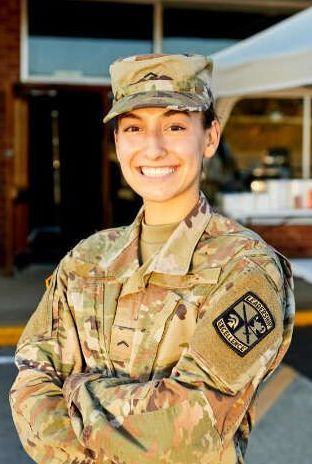
Online Discounts
At Liberty University, we believe everyone should have an equal opportunity to pursue higher education, and it's our job to keep private education affordable. Explore the many ways a Liberty education can be an affordable one.
For online students

Academic Excellence
Liberty University is institutionally accredited by the Southern Association of Colleges and Schools Commission on Colleges, and certain programs have earned additional field-specific accreditation as well.
- Skip to main content
- Keyboard shortcuts for audio player
Your Health
- Treatments & Tests
- Health Inc.
- Public Health
Why writing by hand beats typing for thinking and learning
Jonathan Lambert

If you're like many digitally savvy Americans, it has likely been a while since you've spent much time writing by hand.
The laborious process of tracing out our thoughts, letter by letter, on the page is becoming a relic of the past in our screen-dominated world, where text messages and thumb-typed grocery lists have replaced handwritten letters and sticky notes. Electronic keyboards offer obvious efficiency benefits that have undoubtedly boosted our productivity — imagine having to write all your emails longhand.
To keep up, many schools are introducing computers as early as preschool, meaning some kids may learn the basics of typing before writing by hand.
But giving up this slower, more tactile way of expressing ourselves may come at a significant cost, according to a growing body of research that's uncovering the surprising cognitive benefits of taking pen to paper, or even stylus to iPad — for both children and adults.
Is this some kind of joke? A school facing shortages starts teaching standup comedy
In kids, studies show that tracing out ABCs, as opposed to typing them, leads to better and longer-lasting recognition and understanding of letters. Writing by hand also improves memory and recall of words, laying down the foundations of literacy and learning. In adults, taking notes by hand during a lecture, instead of typing, can lead to better conceptual understanding of material.
"There's actually some very important things going on during the embodied experience of writing by hand," says Ramesh Balasubramaniam , a neuroscientist at the University of California, Merced. "It has important cognitive benefits."
While those benefits have long been recognized by some (for instance, many authors, including Jennifer Egan and Neil Gaiman , draft their stories by hand to stoke creativity), scientists have only recently started investigating why writing by hand has these effects.
A slew of recent brain imaging research suggests handwriting's power stems from the relative complexity of the process and how it forces different brain systems to work together to reproduce the shapes of letters in our heads onto the page.

Your brain on handwriting
Both handwriting and typing involve moving our hands and fingers to create words on a page. But handwriting, it turns out, requires a lot more fine-tuned coordination between the motor and visual systems. This seems to more deeply engage the brain in ways that support learning.

Shots - Health News
Feeling artsy here's how making art helps your brain.
"Handwriting is probably among the most complex motor skills that the brain is capable of," says Marieke Longcamp , a cognitive neuroscientist at Aix-Marseille Université.
Gripping a pen nimbly enough to write is a complicated task, as it requires your brain to continuously monitor the pressure that each finger exerts on the pen. Then, your motor system has to delicately modify that pressure to re-create each letter of the words in your head on the page.
"Your fingers have to each do something different to produce a recognizable letter," says Sophia Vinci-Booher , an educational neuroscientist at Vanderbilt University. Adding to the complexity, your visual system must continuously process that letter as it's formed. With each stroke, your brain compares the unfolding script with mental models of the letters and words, making adjustments to fingers in real time to create the letters' shapes, says Vinci-Booher.
That's not true for typing.
To type "tap" your fingers don't have to trace out the form of the letters — they just make three relatively simple and uniform movements. In comparison, it takes a lot more brainpower, as well as cross-talk between brain areas, to write than type.
Recent brain imaging studies bolster this idea. A study published in January found that when students write by hand, brain areas involved in motor and visual information processing " sync up " with areas crucial to memory formation, firing at frequencies associated with learning.
"We don't see that [synchronized activity] in typewriting at all," says Audrey van der Meer , a psychologist and study co-author at the Norwegian University of Science and Technology. She suggests that writing by hand is a neurobiologically richer process and that this richness may confer some cognitive benefits.
Other experts agree. "There seems to be something fundamental about engaging your body to produce these shapes," says Robert Wiley , a cognitive psychologist at the University of North Carolina, Greensboro. "It lets you make associations between your body and what you're seeing and hearing," he says, which might give the mind more footholds for accessing a given concept or idea.
Those extra footholds are especially important for learning in kids, but they may give adults a leg up too. Wiley and others worry that ditching handwriting for typing could have serious consequences for how we all learn and think.
What might be lost as handwriting wanes
The clearest consequence of screens and keyboards replacing pen and paper might be on kids' ability to learn the building blocks of literacy — letters.
"Letter recognition in early childhood is actually one of the best predictors of later reading and math attainment," says Vinci-Booher. Her work suggests the process of learning to write letters by hand is crucial for learning to read them.
"When kids write letters, they're just messy," she says. As kids practice writing "A," each iteration is different, and that variability helps solidify their conceptual understanding of the letter.
Research suggests kids learn to recognize letters better when seeing variable handwritten examples, compared with uniform typed examples.
This helps develop areas of the brain used during reading in older children and adults, Vinci-Booher found.
"This could be one of the ways that early experiences actually translate to long-term life outcomes," she says. "These visually demanding, fine motor actions bake in neural communication patterns that are really important for learning later on."
Ditching handwriting instruction could mean that those skills don't get developed as well, which could impair kids' ability to learn down the road.
"If young children are not receiving any handwriting training, which is very good brain stimulation, then their brains simply won't reach their full potential," says van der Meer. "It's scary to think of the potential consequences."
Many states are trying to avoid these risks by mandating cursive instruction. This year, California started requiring elementary school students to learn cursive , and similar bills are moving through state legislatures in several states, including Indiana, Kentucky, South Carolina and Wisconsin. (So far, evidence suggests that it's the writing by hand that matters, not whether it's print or cursive.)
Slowing down and processing information
For adults, one of the main benefits of writing by hand is that it simply forces us to slow down.
During a meeting or lecture, it's possible to type what you're hearing verbatim. But often, "you're not actually processing that information — you're just typing in the blind," says van der Meer. "If you take notes by hand, you can't write everything down," she says.
The relative slowness of the medium forces you to process the information, writing key words or phrases and using drawing or arrows to work through ideas, she says. "You make the information your own," she says, which helps it stick in the brain.
Such connections and integration are still possible when typing, but they need to be made more intentionally. And sometimes, efficiency wins out. "When you're writing a long essay, it's obviously much more practical to use a keyboard," says van der Meer.
Still, given our long history of using our hands to mark meaning in the world, some scientists worry about the more diffuse consequences of offloading our thinking to computers.
"We're foisting a lot of our knowledge, extending our cognition, to other devices, so it's only natural that we've started using these other agents to do our writing for us," says Balasubramaniam.
It's possible that this might free up our minds to do other kinds of hard thinking, he says. Or we might be sacrificing a fundamental process that's crucial for the kinds of immersive cognitive experiences that enable us to learn and think at our full potential.
Balasubramaniam stresses, however, that we don't have to ditch digital tools to harness the power of handwriting. So far, research suggests that scribbling with a stylus on a screen activates the same brain pathways as etching ink on paper. It's the movement that counts, he says, not its final form.
Jonathan Lambert is a Washington, D.C.-based freelance journalist who covers science, health and policy.
- handwriting
Everyone needs someone, and RWN gave me that, at a very vulnerable time in my life!

I’ve come out of my shell, I have the confidence to read and write and my tutor has so much patience.

It's one of the best organisations there is, the way they deal with things, compassionate, listening. It helped me more in the first 4-5 weeks than my entire school life.

Free tutoring
for adults wanting to learn and improve their reading, writing, maths, study or digital skills.

Find out everything you need to know about getting help to read and write.

Help Others
Can you help someone to read and write? Find out everything you need to know about volunteering.
What's News?

National Volunteer Week
It is National Volunteer Week and it’s time to celebrate our amazing, dedicated Read Write Now volunteer tutors.
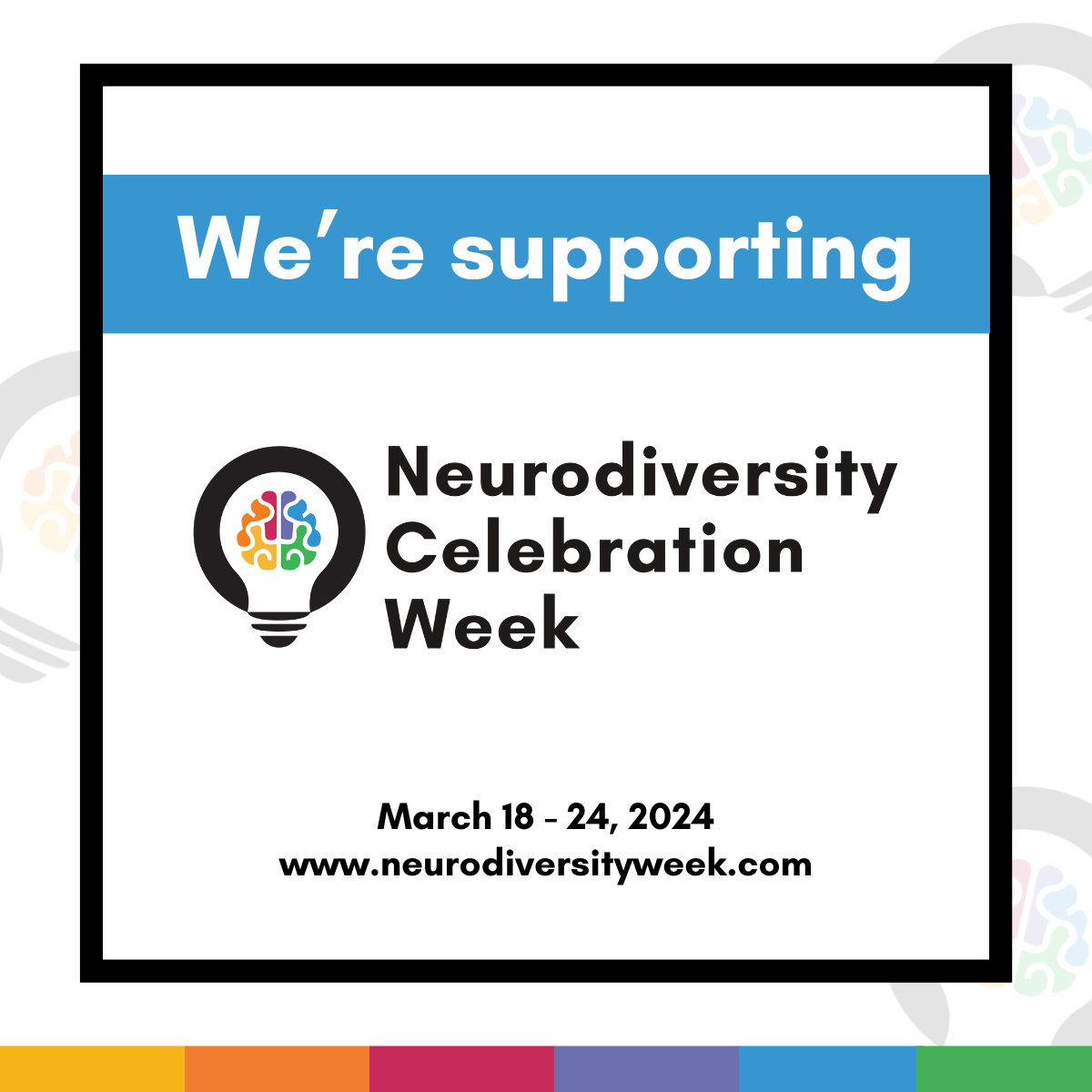
It's Neurodiversity Celebration Week!
This worldwide initiative aims to challenge stereotypes and misconceptions about neurological differences.

Harmony Week
62% of RWN students are culturally and linguistically diverse (CaLD) and of non-English speaking background.

RWN Student Support
The beginning of the semester is a good time to remind students about the free Read Write Now tutoring support service.
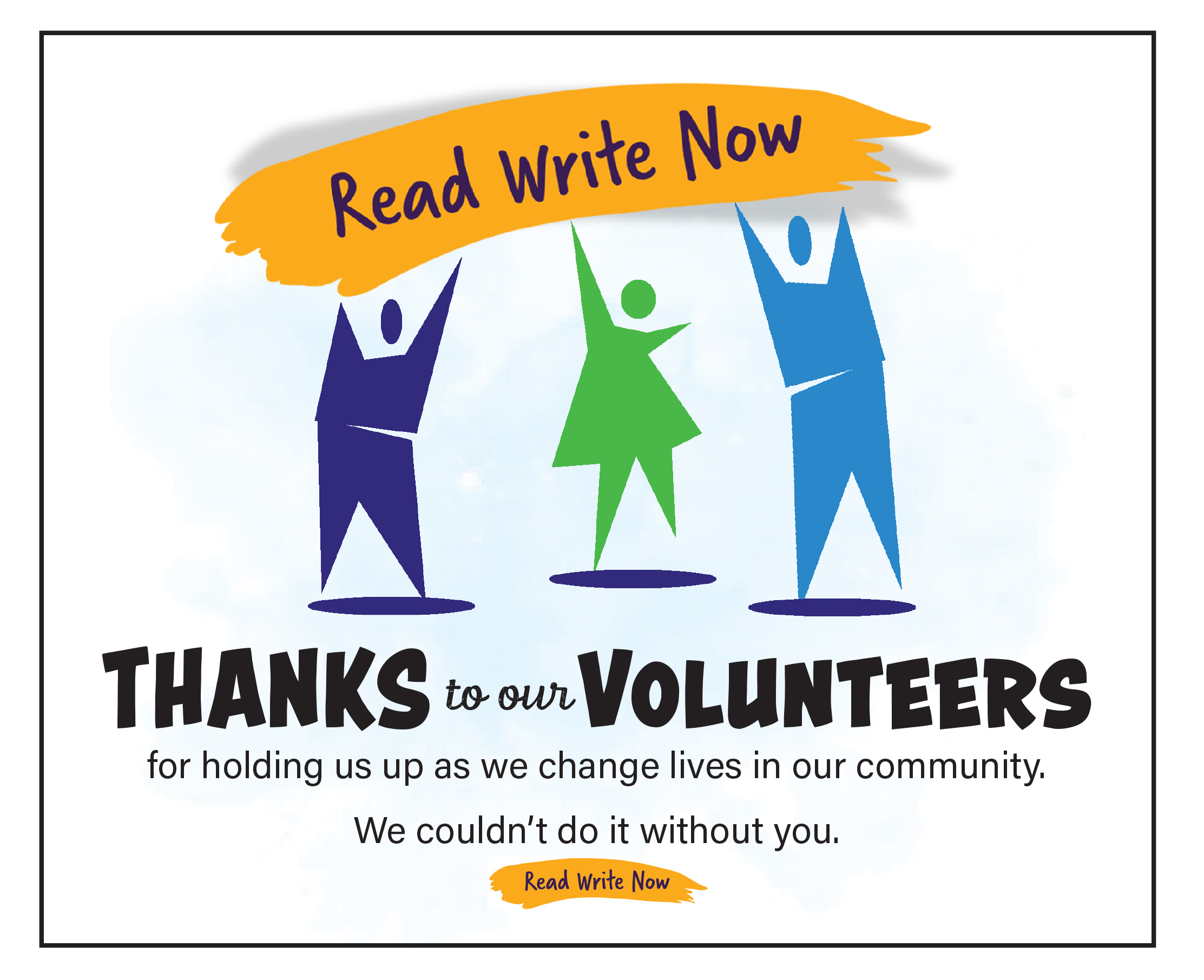
International Volunteer Day
Thank you to our amazing volunteer tutors!
Contact Details
Locked Bag 6, Northbridge WA 6865
1800 018 802

Getting Started on Your Paper: The Skills Nobody Taught You
by Mary Dahl
What are you avoiding right now?
Come on. There’s no way you’re reading this unless you’re avoiding something. You’ve got an Overleaf document open. You’ve copy and pasted the abstract that was accepted into the conference you applied to months ago. You’ve got your literature review spreadsheet, your results, and code open. You’ve locked in on your favorite song, “ 8 Hours Super Deep Brown Noise Sleep, Study, Focus NO ADS.”
And you’re in another tab. Any other tab.
If you’re anything like me, actually getting started writing is harder than any other part of the writing process. For most writing assignments in undergrad and through my masters, I would consistently find myself waffling through writing something, unable to focus and make significant progress. Suddenly, when the due date was upon me, I’d finally find my focus, as the time pressure gave me no choice. One miserable all-nighter later? Paper done. Never punished.
Maybe this was sustainable when I was an undergrad, but I’m old now. My body can’t run off of stale brownies pilfered from free food events and tea flavored by the crusty remnants of previous cups anymore.
I have bad news: those habits are a large reason why focusing on starting writing is hard now. My brain has been wired to associate writing with painful crunches. Trying to start writing tells my brain it’s time to go into crisis mode, and the stress puts me off of it entirely.
I had to find another way, and you can too.
Here are 7 tips I’ve found that are helpful for coping with getting started. Not all of these may work for you, since everyone is different, but you won’t know until you try.
1. Understand why you can’t focus
The first step to solving a problem is admitting you have a problem. We treat focus as something you choose not to do, but that isn’t the case at all. If your solution to being unable to focus is to yell “FOCUS” at yourself, you just stress yourself out, which makes you want to relax, which puts you on Instagram, which makes you mad for “wasting time,” ad infinitum. Your limited focus is a resource that you drain the more you allow yourself to multitask.
Set yourself up for success by structuring your time . If you have a set amount of time for working on something before you can take a break, it is easier to avoid doing your “break” things while working. I have a little extension on my browser , as well as this website , that I can click to start a 25 minute timer. During this time, I only work on a single task and mute everything else. Once it’s over, I take a short break. I emphasize this to myself by listening to different kinds of music in work and break blocks. Building this habit helps disincentivize mind wandering.
You can take this a step further by structuring your entire day. Break up projects and tasks and mark which hours you’re going to work on each in your calendar. Extend this beyond work too – from 8-9 PM tonight, you’re reading a book!
When you do find your focus drifting during a work block, don’t get mad at yourself, but also don’t indulge it. You don’t do things for no reason: whatever you’re getting distracted by matters. Are you distracted by another piece of work? Makes sense: has to get done too. Are you distracted by a recommended YouTube video? Also makes sense: you like them. Don’t punish yourself for liking things! Write down what you got distracted by, why (and yes, your why can just be “I like Pikachu”) , and then go through the list during your next break.
If you are interested in finding out more, in much more detail, I recommend this YouTube video. It’s witty, well researched, and thorough, and discusses this better than I ever could.
2. Put everything you have in one place
Now that we’re actually in a work block, what do we do? Don’t just jump right into writing a piece on page 1 – that will land you in the frustration-distraction-anger-nothing done loop. Instead, let’s do a productive thing that isn’t the productive thing you’re “supposed” to be doing.
Take out a blank document or a notebook and start noting what resources you have, where they’re located, and a brief summary of what they are. These can be anything relevant to your task. Sure, you have your results and your literature review, but you also might have a slide deck on this topic you made for a lab presentation, or a statement of work from proposing the project. Assess what in them is useful and, more importantly, what is missing. Finding these gaps can be very helpful to give you direction on where to work from.
Once you have all of your resources, put them into buckets. Which pieces are useful for which topics? You have some snippets of work that go into your methods. You have some data that you have half a plotting code written for that would go in this section.
You can structure these into a flowchart if you’re feeling really ambitious. Again, nothing too fancy. Mark how your ideas lead logically into each other and make notes on what’s missing.

This is a model for an organizational flowchart from “How to Write a Paper” by Mike Ashby, another fantastic resource about the more technical aspects of paper writing. Ashby organizes the ideas and needs for the paper into different areas. All rights reserved by author.
Okay great. Guess what you just made?
An outline.
That’s right. I tricked you into making your outline.
Plenty of people find the act of “making an outline” useless, but, more often than not, it’s because they were never taught how to properly make one. If all you think an outline is is INTRO METHODS RESULTS DISCUSSION CONCLUSION bulleted list, yeah, that doesn’t give you any direction. By instead connecting your actual content to it, you make less of a map for your paper and more of a guided tour. This not only gives you important to-dos (concrete tasks beyond “write a paper!” huzzah!), but also gives you assurance that you have already done work.
3. Chunk your tasks
Telling yourself that today you’ll work on your paper is nebulous and scary, but what about telling yourself that today you’re working on three paragraphs of your literature review?
As we have stated already with our foray into focus, the biggest hurdle to getting something done is multitasking. When you’re facing “writing a paper,” there are dozens of substeps you need to handle in order to get it done. If you end up spending 3 minutes on writing a lit review but then 2 minutes looking at requirements for the paper but then oh wait you need to spend another minute on rereading this one paper and – and – and –
Well, you’re left with a bunch of disorganized notes all over the place. Odds are, you’ll forget exactly what was done during this time and may need to do it all again. Be more disciplined and organized about this. If you’re working on your literature review, that is all you’re working on.
The bonus to this tip is it works fantastic with tips 1 and 2. Tip 2 (sneaky outlining) gives you specific TODO tasks that can really easily be chunked into these microtasks. Tip 1 (focus time) suggests making specific blocks of time for yourself to do things. You can assign those chunks to 25 minute long work periods! Now you know precisely what you’re working on, when you’re working on it, and how long you will be working on it.
4. Write it terribly
Have you ever noticed that it’s a lot easier to criticize things than it is to make things? You can probably give me a hundred reasons why The Rise of Skywalker was a bad movie, picking out specific scenes and plot points you would change if you could. But if I shoved you in a time machine, sent you back to 2018, and assigned you to write the ninth Star Wars movie from scratch, you’d almost certainly fail, possibly just as spectacularly. Starting fresh is much harder than starting off a baseline.
You can make your own baseline: instead of writing something good, write your paper as bad as humanly possible to start.
I was struggling on an introduction once and wrote this instead:
Satellite data collection – what can’t it do? It has blessed us mortals with the ability to spy on our marble from the heavens as if we were gods. Even blurry, smudged pictures taken from cameras strapped to pizza boxes delight and amaze. The curve of the Earth is more beautiful than… no, I shan’t say it.
This isn’t a usable piece of text, but you can break it apart to find what is usable in it. The ideas are in there: all you need to do is doctor them into something useful.
You can also turn this method down somewhat. Instead of writing poorly on purpose, word vomit. Rip the backspace key off of your keyboard and get typing. Do not let yourself edit as you go: just get it all down. Even if you have mistakes, keep going. Even write “oops nope not that.” Get it all out of your system and don’t care one bit about quality.
There are two main reasons that these methods are useful. First, as I said, ripping apart and editing things you know are bad is easier than generating new things. A blank page is terrifying, but a page full of words is progress. The other reason these methods work? You actually wrote something. You have now turned your brain into “writing mode” instead of “not wanting to write” mode. If you’re familiar with brainstorming techniques, you may have done something similar. In effective brainstorming sessions, you always take “no bad ideas” seriously to a fault. You write everything anyone comes up with down, even if they are clearly just joking. The idea is to get everyone into a mindset where they’re firing their brain up to think of things, which can then spark “real” good ideas. Writing is just the same way!
5. Don’t start at the beginning
Introductions to papers get progressively more boring the longer you’ve been in a field. If I have to read about how CubeSats have revolutionized space one more time, I might eat my computer. They are necessary : they ground what you are writing for unfamiliar readers and clear up common assumptions for experienced readers. This doesn’t make it any easier for you to write it when you’ve read the same type of intro over and over.
Start anywhere else. I usually start with the literature review, since it requires me to think about the topic without having to think about my own work, where I can get caught up on little details. Maybe it’s easier for you to start by summarizing an experiment or a result you have. This can help break up the writer’s block and get you writing.
Another reason that you shouldn’t start at the beginning is to distribute your energy. Be honest with yourself about past papers you have written: have you ever allocated the right amount of time to writing them? You probably spend far too long writing and rewriting the beginning, while you feel like you have plenty of time to get the paper out. As you run out of steam as the due date approaches, your writing quality suffers. Shuffle up the order you write things so you can ensure that you keep some of that early-writing energy for every section of the paper.

Typically, when we write a paper in order, our energy level decreases as we write. Because of this, the quality of our writing peaks at the beginning, which is relatively less important to the paper, and declines as we go. By mixing up the order we write the paper, we can ensure that some of that high energy is dispersed.
6. Move your internal due date up
Oh, that paper is due in a month? Cool, cool, cool.
Nah, it’s due in 2.5 weeks now.
Wow, this sucks! Now you need to be a lot more efficient about getting it done. Now you need to pressure yourself into focusing. The way that you would… do… if… it was last minute… the only time you could write…
Haha, tricked your brain again.
This one can be difficult to actually get done, since you are fully aware you’re trying to trick yourself. (I know that Mary is a liar and that I can in fact have that brownie whenever I want it, thank you very much.) The exact amount of time you trim for your due date is difficult to figure out, but I’d recommend trying to get it done in ⅔ of the time you actually have.
With that extra time, you can actually do substantive edits. Give the whole thing a thorough read through and have better ideas about what needs punching up. It’s even better if you can get your advisor extra time to read it. If you’re really lucky, you might even manage to be able to use that extra time to relax. I mean, probably not, but it would be great!
7. Talk about your paper with someone in a new location
If you are really struggling to get things started or to keep your synthetic due dates, turn to your officemate, your best friend, your milkman, your pet rock, anyone, and ask them if you can grab a coffee and summarize your paper for them. This is the same idea as we’ve been saying: you’re so caught in your own head about the topic that you can’t figure out how to get the words out. You’ve been working on this for so long that you’ve forgotten that you enjoy the topic.
But look at me: you are talking about the paper.
I know, breaks are supposed to be for resetting your brain, but all talking about other things does is make you not want to go back to work. Sorry I have to be a bummer here, but I’m here to try and help you to write your paper. Go to a new location and set an end date for your chat. Just talk about it. The ins and outs, what you’re stuck on. Treat your friend as a sounding board until you’re thinking again. Set your synthetic due dates during this meeting, and check back in with them to show progress.
Man, if only there was a convenient location on MIT campus where you could talk with a colleague about your paper. If only there was some resource where your colleagues have been trained to discuss technical writing at length. If only you could sign up for a half hour or hour long block to discuss your paper, no matter what stage you’re at. Hmmm… oh wait, you could always go to the MIT AeroAstro Communication Lab !
That comes to the end of our list. Hopefully, some combination of these strategies will be helpful to you. In short, remember these two things:
- Make specific time to do specific things.
- Force yourself to get something out, written or out loud.
Now, if you’ll excuse me, I have a thesis proposal to get started on.
7 Exciting Ways To Envision Futuristic Tech in Your Script

Part of the fun of writing science fiction is using your imagination to create new speculative and theoretical technology in your fictional stories. The whole point of sci-fi is to take technology and science to the next level as you showcase the human reactions to the benefits, the dangers, and how those advancements affect society of those sci-fi elements.
But how can screenwriters conjure futuristic technology that feels possible and believable enough to avoid readers and audiences having to suspend their disbelief to the point where it feels more like fantasy than potential scientific reality?

Seven Ways To Imagine Futuristic Technologies in Your Script
Here, we offer seven ways screenwriters can enhance their knowledge to imagine plausible future tech in their sci-fi stories.
1. Research Emerging Technologies
Research plays a vital role in any screenplay. When developing a sci-fi with story elements that involve speculative tech or science, doing the proper research will help you find the ability to take current tech and turn it on its head to envision the next possible step sci-fi tales could take.
The first step in imagining future tech is understanding what is currently on the horizon. You should do your best to stay informed about the latest developments in science and technological fields like:
- Artificial intelligence
- Biotechnology
- Space exploration
- Quantum computing.
- Conceptual War Technology
Websites, scientific journals, and technology-focused conferences can be invaluable resources. This grounding in reality makes the next speculative steps you take more credible and engaging.
For example, look at the technology in Steven Spielberg’s Minority Report .
The film’s speculative future tech was way ahead of its time and stands the test of time by predicting some of the technology we have today. Do your research and find those budding technologies.
Read More: 7 Things To Remember While Researching Your Screenplay
2. Engage with Futurists and Technologists
Part of your research can involve collaborating with scientific and technological influencers and professionals who can help keep you up to speed with what may be on the horizon.
Networking with experts specializing in predicting technological trends can provide insights into where technology might be headed . A few ways to do this are by:
- Engage with futurists
- Attending tech talks
- Consult with scientists
These practices can open up new perspectives and possibilities for your sci-fi stories.

'Doctor Who' (1963-)
3. Explore Science Fiction Literature and Media
Classic and contemporary sci-fi literature, films, and shows offer a treasure trove of ideas that have shaped expectations about the future. Sci-fi franchises and movies like Star Trek and 2001: A Space Odyssey have inspired technological concepts and advances. It’s all about taking what’s realized and familiar and pushing the boundaries even further to see what could be possible.
When you dive into the sci-fi genre on all platforms, you can build on the ideas, expand them, or take them in entirely new directions based on emerging scientific principles—and your creative design.
Read More: 131 Sci-Fi Scripts That Screenwriters Can Download and Study

'2001 A Space Odyssey' (1968)
4. Consider Societal Impact
Ask yourself:
- How might these innovations change the way we interact?
- How could the technology change how people work?
- Would this technological advancement affect how people govern themselves?
This approach adds depth to the narrative and engages the audience on a deeper philosophical level. It makes otherwise technical dynamics more relatable because the eventual audience will ponder the pros and cons of the future technology you imagine.

'Inception' (2010)
5. Humanize Technology Through Character and Story
The best sci-fi doesn't just introduce new technology—it explores its impact on individuals and cultures. Screenwriters should weave technology into the personal stories of their characters:
- How does the tech help or hinder them?
- What conflicts does it create?
- How does it affect their relationships?
This human element makes the story more relatable and the technology more tangible.
Look at the film Her as a perfect example of this. It tells the story of a man who falls in love with the new artificial intelligence (AI) program on his phone.
Write/director Spike Jonze gave us a future technology based on then-current rising trends in technology. More than a decade later, the debate on AI is at an all-time high as AI technology has drastically changed with more and more advancements each month.
However, the screenplay and eventual film never bombarded us with the technical aspects of the future tech. Instead, it reached us through cathartic and empathetic paths by having a lonely man fall in love. We relate to new and exciting relationships. The audience lives vicariously through this character because we see relatable elements, perspectives, and emotions.
If you can weave your future tech designs into the characters and the narrative they reside in, you’ll be able to offer future technology that is subtle but powerful.
6. Use Visual and Contextual Descriptions Effectively
How technology is described in a screenplay can influence how it is understood by script readers and audiences. Always strive to provide clear, vivid descriptions that give production designers and directors a strong vision of what the tech looks like and how it functions.
But there’s also a line you don’t want to cross.
Always avoid overly technical jargon unless it enhances the story or character development. It goes back to the old expression, “ All I wanted to know was the time, and you went and explained to me how a watch works .”
We don’t need to know how the tech works unless , again, we use that knowledge to enhance the story or character development. Just show us the future tech in action.
Read More: How White Space Makes Your Screenplays Better

'Andor' (2022-)
7. Adapt to New Discoveries
Technology evolves rapidly, and what may seem cutting-edge at the time of writing could be outdated by the time you get an industry insider to read your script—let alone get your script produced. It could take years.
Always remain adaptable. Update your scripts as new information becomes available or as real-world technology surpasses your imagined tech.

'Poor Things' (2023)
By following these steps, you can predict future technologies and craft stories exploring the complex relationship between humans and the tech that surrounds them, making for compelling and thought-provoking narratives.
Read More: 5 Benefits To Constructing a Fictional Language
CHECK OUT OUR PREPARATION NOTES SO YOU START YOUR STORY OFF ON THE RIGHT TRACK!

Ken Miyamoto has worked in the film industry for nearly two decades, most notably as a studio liaison for Sony Studios and then as a script reader and story analyst for Sony Pictures.
He has many studio meetings under his belt as a produced screenwriter, meeting with the likes of Sony, Dreamworks, Universal, Disney, Warner Brothers, as well as many production and management companies. He has had a previous development deal with Lionsgate, as well as multiple writing assignments, including the produced miniseries Blackout, starring Anne Heche, Sean Patrick Flanery, Billy Zane, James Brolin, Haylie Duff, Brian Bloom, Eric La Salle, and Bruce Boxleitner, the feature thriller Hunter’s Creed, and many Lifetime thrillers. Follow Ken on Twitter @KenMovies and Instagram @KenMovies76
Get Our Screenwriting Newsletter!
Get weekly writing inspiration delivered to your inbox - including industry news, popular articles, and more!
Facebook Comments
Free download.

Screenwriting Resources:

$ 15.00 Original price was: $15.00. $ 12.00 Current price is: $12.00. Add to cart
Popular Posts

Recent Posts

Next Related Post

Get Our Newsletter!
Developing your own script.
We'll send you a list of our free eCourses when you subscribe to our newsletter. No strings attached.
You Might Also Like

- Hidden Name
- Name This field is for validation purposes and should be left unchanged.
Connect With Us
Writing competitions, success stories.
© 2024 ScreenCraft | An Industry Arts Company
English Use arrow key to access related widget.
- Customer Service
- My USPS ›
- Español
Top Searches
Alert: USPS.com is undergoing routine maintenance from 10 PM ET, Saturday, May 18 through 4 AM ET, Sunday, May 19, 2024. During this time, you may not be able to sign in to your account and payment transactions on some applications may be temporarily unavailable. We apologize for any inconvenience.
Alert: Some of our applications may be unavailable during routine maintenance from Saturday, May 11 through Sunday, May 12. We apologize for any inconvenience.
Alert: Severe weather in the South, Southeast, and Midwest may impact package delivery. Read More ›
Alert: The online Postal Store is currently unavailable. We are working to resolve the issue and apologize for the inconvenience.
Alert: We are currently experiencing issues with some of our applications. We are working to resolve the issues and apologize for the inconvenience.
Alert: USPS.com is undergoing routine maintenance from 10 PM ET, Saturday, March 9 through 4 AM ET, Sunday, March 10, 2024. During this time, you may not be able to sign-in to your account and payment transactions on some applications may be temporarily unavailable. We apologize for any inconvenience.
Alert: Severe weather conditions across the U.S. may delay final delivery of your mail and packages. Read more ›
Alert: USPS.com is undergoing routine maintenance from 11 PM ET, Saturday, March 2 through 4 AM ET, March 3, 2024. During this time, payment transactions on some applications will be temporarily unavailable. We apologize for any inconvenience.
Alert: We are currently experiencing issues with some of our applications. We apologize for the inconvenience.
Alert: Payment transactions on some applications will be temporarily unavailable from 11 PM ET, Saturday, January 6 through 3 AM ET, Sunday, January 7, 2024. We apologize for any inconvenience.
Alert: Some of our applications are undergoing routine maintenance on Monday, October 30 from 10-11 PM ET and may be unavailable. We apologize for any inconvenience.
Alert: Some of our applications are undergoing routine maintenance from Saturday, August 26 through Sunday, August 27 and may be unavailable. We apologize for any inconvenience.
Image of play button
Find out how to send mail. 1:53
Video Description: How to Send a Letter or Postcard (TXT 4 KB)
How to Send a Letter or Postcard: Domestic
Sending mail with USPS is easy! Our video will help you with most letters, cards, and postcards you send domestically (inside the U.S.), including U.S. territories and military bases in the U.S. and abroad.
For how to ship a package, see How to Send a Package: Domestic .
Send Mail: Step-by-Step Instructions
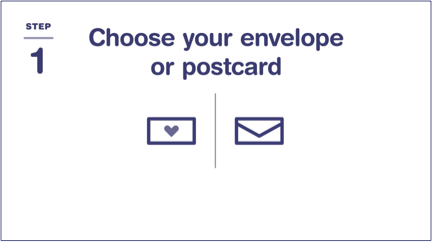
Step 1: Choose Envelope or Postcard
Envelopes are for sending flat, flexible things, like letters, cards, checks, forms, and other paper goods. For just 1 $0.68 First-Class Mail ® Forever ® stamp , you can send 1 oz (about 4 sheets of regular, 8-1/2" x 11" paper in a rectangular envelope) to anywhere in the U.S.!
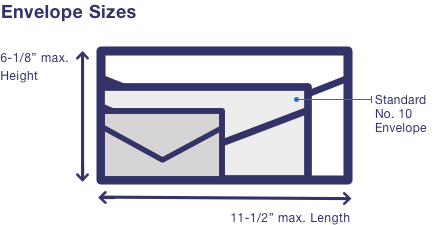
Envelopes must be rectangular and made of paper to qualify for letter prices. Your envelope can be a maximum of 11-1/2" long x 6-1/8" high. (A standard No. 10 envelope is 9-1/2" long x 4-1/8" high.) You can fold what you put in your envelope, but it needs to stay flat—no more than 1/4" thick.
If you want to send letter-sized papers without folding them, you can use a large envelope (called a "flat"); the postage for flats starts at $1.39 . If your large envelope is nonrectangular, rigid (can't bend), or lumpy (not uniformly thick), you'll have to pay the package price.
TIP: If your envelope can't fit through USPS mail processing machines, or is rigid, lumpy or has clasps, string, or buttons, it's "nonmachinable" and you'll have to pay $0.44 more to send it. ( See additional postage in Step 3 .) You'll also have to pay more if your envelopes are square or vertical (taller than they are wide).
Postcards are for short messages that you don't need to put in an envelope. Save money using a $0.53 postcard stamp to send a standard-sized postcard anywhere in the U.S. Standard postcards are usually made of paper, are between 5" to 6" long and 3-1/2" to 4-1/4" high, and are between 0.007" and 0.016" thick.
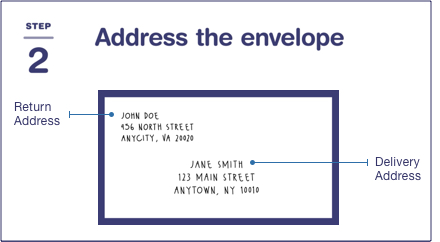
Step 2: Address Your Mail
Envelopes: Write your address (the "return" or "sender" address) in the top left corner. Write the delivery address (the "recipient" address) in the bottom center.
Postcards: Postcards come in different formats, so write the delivery address in the space it gives you (on the same side you write your message and put the stamp).
Print your return address and the delivery address clearly, in the correct spots, to make sure your mail is delivered on time.
Address Format Tips
- Use a pen or permanent marker.
- Do not use commas or periods.
- Include the ZIP+4 ® Code whenever possible.
Write Sender Address
Write your address (the "return address") in the top-left corner. Include the following on separate lines:
- Your full name or company name
- Apartment or suite number
- Full street address
- City, State, and ZIP+4 Code
Write Delivery Address
Write the delivery address (the "recipient" address) in the bottom center of the envelope. Include the following on separate lines:
- Recipient's full name or company name
If the apartment or suite number cannot fit on the delivery address line above the city, state, and ZIP+4 Code, place it on a separate line immediately above the delivery address line.
Write the sender's address in the top-left corner. Include the following on separate lines:
- Full street address and apartment or suite number, if applicable
Special U.S. Addresses
Puerto rico.
Some Puerto Rico addresses include an urbanization or community code for a specific area or development. Addresses with an urbanization code, abbreviated URB, should be written on 4 lines:
MS MARIA SUAREZ URB LAS GLADIOLAS 150 CALLE A SAN JUAN PR 00926-3232
More Puerto Rico Address Examples
U.S. Virgin Islands
Virgin Islands addresses have the same format as standard addresses. The right abbreviation for this territory is "VI," not "US VI" or "USA VI":
MS JOAN SMITH RR 1 BOX 6601 KINGSHILL VI 00850-9802
Military and Diplomatic Mail (APO/FPO/DPO)
Mail to military and diplomatic addresses is treated differently:
- Do not include the city or country name when you send something to an APO/FDO/DPO address in another country. This keeps your mail out of foreign mail networks.
- Do include unit and box numbers if they're assigned:
SEAMAN JOSEPH SMITH UNIT 100100 BOX 4120 FPO AP 96691
More Details on Military Addresses
When you're done addressing your envelope, put what you're sending inside the envelope, then close and seal it (using the envelope's glue or tape).
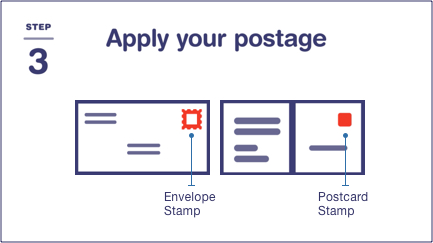
Step 3: Calculate Postage (& Add Insurance or Extra Services)
A First-Class Mail ® Forever stamp costs $0.68 and goes in the upper right corner of the envelope. (You can also use any combination of stamps that adds up to $0.68.)
If your letter is heavier or bigger, or if you want to add insurance or extra services like Certified Mail ® service, you'll pay more.
A standard postcard stamp costs $0.53 . (Large or square postcards will cost more.) Put the postcard stamp in the space provided near the delivery address.

Postage for letters mostly depends on weight and size/shape. You can weigh your letter with a kitchen scale, postal scale , at a self-service kiosk, or at the Post Office ™ counter.
TIP: As a rule of thumb, you can send 1 oz (4 sheets of printer paper and a business-sized envelope) for 1 First-Class Mail ® Forever ® stamp (currently $0.68).
The postage for a large envelope (or flat) starts at $1.39 for 1 oz.
Where Can I Buy Postage?
- The Postal Store ® Shop online for all stamps and add-on postage for oversized or heavier envelopes.
- Post Office Locations Buy stamps at Post Office locations , self-service kiosks , or at National Retailers such as grocery and drug stores.
TIP: If you're sending larger envelopes (flats) using Priority Mail ® or Priority Mail Express ® service, you can use Click-N-Ship ® service to pay for and print your own postage online.
Additional Postage
If your envelope weighs over 1 oz, you can buy additional postage in the amount you need:
- Each additional 1 oz is $0.24, for letters up to 3.5 oz and large envelopes up to 13 oz.
- Nonmachinable items, including envelopes that are lumpy or rigid, or have clasps, string, or buttons will cost $0.44 more to send. You'll also have to pay more if your envelopes are square or vertical (taller than they are wide).
- You can also buy 1¢, 2¢, 3¢, 4¢, 5¢, and 10¢ stamps at The Postal Store .
TIP: Put the stamp on last; that way, if you make a mistake at any other point, you won't waste a stamp.
Calculate a Price
Add-On Services
If you want insurance, proof of delivery, signature services, or other optional services, you'll have to pay extra.
Our Insurance & Extra Services page has more details; some of the more common add-on services for letters include:
- Certified Mail ® : Get proof that you mailed your item and that the recipient signed for it.
- Registered Mail ® : USPS's most secure mail service–mail is processed manually, handled separately and securely, and signed for along every step of its journey. The recipient must sign for the mail to confirm delivery (or attempted delivery).
- Return Receipt: You'll get a printed or emailed delivery record showing the recipient's signature. You can combine Return Receipt with other services, including Certified Mail, Registered Mail, Priority Mail Express ® service, and more.
- Adult Signature Required: Only an adult (age 21+) can sign for the mail after showing a valid government ID .
Postage Options
There are several ways to get postage for your envelope.
- The Postal Store ® --> ® and Priority Mail Express ® envelopes.
- Post Office ™ Locations --> ® such as grocery and drug stores.
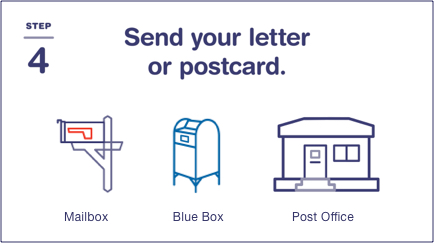
Step 4: Send Your Mail
Once your envelope or postcard has the correct addresses and postage, you can send it several ways, including putting it in your mailbox or dropping it in a blue collection box or at a Post Office ™ location.

- Put your letter inside your mailbox and raise the flag (if you have one).
- If you have a cluster mailbox, drop it in the outgoing mail slot.
- Drop it off in a blue collection box.
- Take it to a Post Office lobby drop.
Important Note: If your envelope has postage stamps and weighs more than 10 oz or is thicker than 1/2", you can't put it in a collection box; you have to give it to an employee at a Post Office location. See more details on What Can and Cannot be Deposited in a Collection Box?
Bonus: Sending Mail Pro Tips
The Postal Service uses high-speed sorting machines to help process and deliver 425.3 million mail pieces each day. Here are some extra tips to improve your mail sending experience:
- Stay flexible : Don't send rigid (hard) objects in paper envelopes.
- Sending embellished invitations (for weddings, graduations, etc.)? Get them hand-canceled or put them inside another envelope.
- Need tracking? Learn about your options.
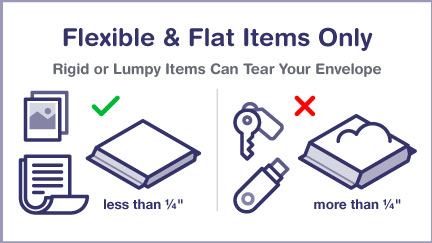
Stay Flexible
Postcards, letter envelopes, and large envelopes (flats) all need to bend to fit through USPS ® high-speed sorting machines.
- OK: Flexible, flat things like stickers, photos, trading cards, etc. should be okay—as long as your envelope stays flat, not lumpy, and less than 1/4" thick.
- Not OK: Don't put rigid objects (like flash drives, coins, keys, hard plastic card cases, etc.) loose in unpadded paper envelopes: They could get torn out of the envelope, jam the sorting machines, cause a delay, or even get lost.
Instead, for rigid and odd-shaped objects (or things you don't want to get bent), we recommend using a padded envelope or small box and sending it as a package .
Sending Embellished Invitations (for Weddings, Graduations, etc.)
If you want to send a specially decorated envelope (like some wedding invitations):
- You can pay the extra fee for nonmachinable First-Class Mail ® items, bring your mail to the Post Office™ counter, and ask the retail associate to hand-cancel your embellished invitations.
- For externally decorated invitations: If you use wax seals, strings, ribbons, etc. on your envelopes, don't try to send them exposed. Instead, to make sure your envelopes arrive looking the way your designer intended, put them inside another envelope .
Need Tracking?
Tracking is not available for First-Class Mail items. If you'd like to get tracking information for your letter:
- You can pay extra to send your letter using Priority Mail Express ® or Priority Mail ® service.
- You can get delivery confirmation by adding Certified Mail ® or Registered Mail ® service. (You can even combine it with Return Receipt if you want the recipient's signature.)
StarTribune
Labor then and now: 90 years after the minneapolis teamsters' strikes.
Opinion editor's note: Star Tribune Opinion publishes a mix of national and local commentaries online and in print each day. To contribute, click here .
This year marks the 90th anniversary of the 1934 Minneapolis Teamsters' strikes. These strikes changed the course of history and the lives of tens of thousands of working people. They transformed Minneapolis from one of the country's most notorious anti-union citadels into a "union town" and inspired labor organization from Fargo to Omaha and Duluth to St. Louis. The story of this transformation still resonates with the challenges faced by working women and men in 2024.
In the late 19th century a vibrant and diverse labor movement surged across the state of Minnesota. Its ranks included native-born and immigrant workers employed as flour millers and barrelmakers, railroad engineers, firemen, brakemen and track workers, garment workers and laundresses, horse and wagon drivers, building trades craftsmen, longshoremen and stevedores, skilled machinists and shop workers. They were affiliated with the Knights of Labor, the American Federation of Labor, the railroad brotherhoods, the Teamsters and the American Railway Union, and they created cooperatives, mutual benefit societies and a broad-based movement for the eight-hour day. These workers participated in the Great Northern Railroad and Pullman strikes of 1894 and built political alliances with farmers. In the early 20th century, many of them took part in the creation of the Industrial Workers of the World and the Socialist Party, and they challenged some of the biggest businessmen in the U.S., including James J. Hill, Andrew Carnegie and Charles Pillsbury.
But bankers, businessmen and their political representatives launched a powerful counteroffensive to regain control of their workplaces and secure their domination of the city and the state. The core of their strategy was to eliminate unions through a double-blacklist (a refusal to hire union members and a refusal to extend loans to employers who bargained with unions). They created a new organization with a slippery rhetorical name — the "Citizens' Alliance" — not only to implement their strategy but also to spin it as a defense of individual independence. Their effectiveness won them the accolades of the National Association of Manufacturers, the National Civic Federation, Chambers of Commerce and employers' organizations across the country. Minneapolis became an icon of non-unionism.
The Citizens' Alliance's success was devastating not just for unions but also for working men and women. Over the course of the 1910s and 1920s, workers were disciplined, fired and blacklisted at the whim of employers. Although productivity rose with the introduction of new modes of work organization and new technologies, wages lagged. Workers struggled to support their families and find economic security. And when workers organized to challenge the Citizens' Alliance, such as the St. Paul streetcar workers' strike of 1917 or the election of Socialist trade unionist Thomas Van Lear to the mayoralty of Minneapolis in that same year, businessmen trumpeted the ideology of wartime "loyalty" and leveraged state government to provide resources, such as the Public Safety Commission, to limit workers' gains. The reign of the Citizens' Alliance seemed untouchable, despite the establishment of the Farmer Labor Party in 1924, the crash of the national economy in 1929, the election of Floyd B. Olson as governor in 1930 and the election of Franklin Delano Roosevelt to the presidency in 1932.
Then in the winter of 1934, a small group of experienced, dedicated labor activists began to change the course of history. Several of them had been working in the city's coal yards, earning miserable wages for handling and delivering the coal that Minneapolitans used to heat their homes, apartments and businesses. Members of the 75-member Teamsters Local 574, they initiated a strike on Feb. 7 that spread within three hours to 65 of the city's 67 coal yards. They organized "inside" (warehouse and coal yards) and "outside" (drivers and helpers) workers together in an industrial strategy, and they ignored both the New Deal's weak labor board system and the cautious advice of the Teamsters' national leadership. They relied on cruising pickets that shut the entire industry in the midst of a cold snap. Two days later, the coal employers offered the union a settlement, and the strike ended. An estimated 3,000 trucking and warehouse workers signed up to join Local 574. The inspiration was spreading.
In May, Local 574 called a larger strike, all across the city's market district. Again, they linked inside and outside workers, ignored the weak mechanisms of the government labor board, and relied on cruising pickets. Activists built an impressive infrastructure — a rented garage as a strike headquarters from which mobile pickets could be dispatched; a soup kitchen and an infirmary, fully staffed by volunteers, many from the newly organized women's auxiliary; a "committee of 100," mostly stewards from individual shops and warehouses, to make key decisions for the union; a committee of the unemployed, not only to prevent strike-breaking but also to advocate for those without jobs; a network of farmers to bring food for strikers and their families. They also secured the support of other unions and the Central Labor Council. The strike, which lasted 10 days, revolved around control of the streets. Despite police violence, the roving pickets were effective, and on May 25, employers offered an agreement, which the union accepted.
The ink had hardly dried on the agreement, however, when employers began to violate its terms. More than 700 complaints of discrimination were logged in June and early July. On July 17, Local 574 renewed its strike. This time, there were more than 10,000 participants, while 35,000 other workers engaged in a sympathy strike. The union mobilized its resources, adding a new weapon, a daily strike bulletin (the first ever in the U.S.) which they called "The Organizer." Once again, control over the streets was central to the effectiveness of the strike and, this time, there was more violence, even deaths on both sides. One hundred thousand union members and sympathizers took part in a funeral procession for striker Henry Ness. The dispatch of the National Guard and the arrests and imprisonment of many union leaders could not bring the strike to an end. With pressure exerted by Roosevelt through the Reconstruction Finance Corporation, the Citizens' Alliance finally yielded on Aug. 21, and employers were ordered to hold union elections, almost all of which ended in victories for Local 574 and the negotiation of collective bargaining contracts. This broke the more than two decades' reign of the Citizens' Alliance.
Here begins the story of Minneapolis' transformation into a "union town." Some 10,000 truck drivers, helpers, warehouse workers, coal heavers and other unskilled workers not only won substantial raises, but also got seniority provisions and a grievance procedure, both of which held a promise of justice in the workplace itself. Their defeat of the Citizens' Alliance and their success inspired other workers in Minneapolis and St. Paul, across Minnesota and the Midwest, that they, too, could organize and improve their work lives. Rank-and-file teamsters' participation in the strikes and their continuing participation in the life of the union gave them a new awareness of their class position, in contrast with employers and in solidarity with other workers. Their experiences also fueled their sense of their own capacity and power. They shared their new consciousness with their family members, their neighbors and other workers. They also embodied it in expressions of solidarity, from support for the women workers in the Strutwear Knitting strike a year later to the building of an interstate network of trucking workers, and the unionization of packinghouse workers, timber workers, iron miners and steelworkers from Lake Superior to the Iowa border and more. Minneapolis had become a "union town" and workers' activism there was becoming a rising tide to lift all boats.
This situation persisted for half a century, for two generations. It became normal for workers throughout the Midwestern economy to earn a living wage, to enjoy health care benefits, vacations and pensions, to gain access to easier assignments as their seniority grew, and to expect a safe workplace and to be treated respectfully on the job. This was especially true in unionized workplaces, but non-union employers felt pressure to provide similar conditions, as did all levels of government. It was not a labor paradise; workers still worked hard and often felt they deserved a larger share of the wealth they created. But many were able to buy cars and homes, send their children to college and expect to enjoy their retirement years.
This changed abruptly in the 1980s and 1990s. Employers closed plants and exported manufacturing jobs abroad. They reorganized work through outsourcing and subcontracting. They chipped away at benefits, then wages, then unionization itself. While legislatures and judges weakened workers' rights to picket, employers threatened those who still dared to strike with permanent replacement. The unionized cohort of the working class no longer enjoyed economic security, their ability to improve their own conditions was greatly diminished and, increasingly, their role as trendsetters for all workers faded. By the turn of the 21st century, Minneapolis could no longer be called a "union town." For that matter, neither could St. Paul or anywhere else in Minnesota and the Midwest.
But workers' situations have not simply deteriorated; they have changed. Immigrants play an increased role in the economy and are more vocal, visible and significant in the labor movement. Public employees, white-collar workers, retail, service and fast-food workers have come to the fore. Teachers and educational assistants, and health care workers, from doctors and nurses to personal care assistants, see that unionization enables them to provide the care that brought them into their occupations in the first place. Members of Generation Z, struggling for economic security since the recession of 2008-10, are bringing new energy into the labor movement. We are living in exciting times.
This year is a great time to look back at 1934, to learn how a wide range of workers changed the course of history, and to consider how today's workers might change this course themselves. A diverse group of activists, some of them descendants of the 1934 strikers, are organizing a series of events — an art exhibit, a picnic, film screenings and panel discussions — to curate a series of conversations between the past and the present. Join us! Please see rem34.ampmpls.com for details of activities.
Peter Rachleff is an emeritus professor of history at Macalester College and co-founder of the East Side Freedom Library in St. Paul.
- Minneapolis' $18M crime prevention effort questioned after contracts go unpaid
- Bill Walton, Hall of Fame player who became a star broadcaster, dies of cancer at 71
- Souhan: KAT falters again, potentially posing hard questions for Wolves
- Anthony Edwards keeps team upbeat as Timberwolves season circles the drain

In wartime and across lifetimes: The memories that run in the blood
A Memorial Day reflection on duty and its demands
Honor the heroes on memorial day.
Readers Write: Memorial Day, ranked-choice voting, bonding bill, lilacs
Readers Write: Political centrism, Trump's trial, equity in education, Spider John Koerner

- Minneapolis' $18M crime prevention effort questioned after contracts go unpaid 9:30am
- Eyed for decades as a possible murderer, Minnesota man finds himself back in the spotlight May. 26
- This summer let's start treating the parkways like parks • Opinion Exchange
- Labor then and now: 90 years after the Minneapolis Teamsters' strikes • Opinion Exchange
- A Memorial Day reflection on duty and its demands • Opinion Exchange
- Consider the spectacle of the 2024 legislative session • Opinion Exchange
- A guide to Editorial and Commentary • Opinion Exchange
© 2024 StarTribune. All rights reserved.

IMAGES
VIDEO
COMMENTS
Learn to Write Now is a fast-growing educational start-up dedicated to providing high-quality, cost-effective ELA enrichment programs for students of all ages. We are committed to developing strong readers, practiced writers, and spirited thinkers by offering rigorous workshops, engaging clubs, and personalized services. .
Learn to Write Now is a fast-growing educational start-up dedicated to providing high-quality, cost-effective ELA enrichment programs for students of all ages. We are committed to developing strong readers, practiced writers, and spirited thinkers by offering rigorous workshops, engaging clubs, and stellar personalized services. ...
Learn to Write Now. 2024 Summer registrations are now open! NEWS SHOW. Please select the Grade Please select your Timezone Please select the type of program you are interested in > ...
Here are some strategies for developing your own written communication: 1. Review grammar and spelling basics. Grammar and spelling form the foundation of good writing. Writing with proper grammar and spelling communicates your professionality and attention to detail to your reader. It also makes your writing easier to understand.
LTWN's curriculum is based on the National Common Core and Creative Writing standards. Having taught over 1600 students, we know what areas need brush-ups and which require deeper learning. We also realize that students do not want to attend "just another" academic program after school. So the materials must be both engaging and challenging.
At Learn To Write Now we believe big strides in ELA education is possible by consistently doing small practices for a long time. With this in mind we have developed the LTWNApp that teaches ELA in small packets starting with the Five Minute Free Writing. We encourage you to build this into a habit and power up your writing skill. LTWN.
In summary, here are 10 of our most popular writing courses. Write Your First Novel: Michigan State University. Academic English: Writing: University of California, Irvine. Good with Words: Writing and Editing: University of Michigan. Creative Writing: Wesleyan University.
We are now making the content free and available to students who took the course and anyone else who's interested in investigative reporting and data journalism basics, including experienced investigators who seek to deepen their skills on complex investigations, collaborations and data journalism. ... Learn to write READMEs using Markdown so ...
Learn To Write Now, Naperville, Illinois. 1,388 likes · 3 talking about this. K - 12 English Enrichment Workshops including Writing, Reading, Test Prep in small Online classes
Since 2008,Learn to Write Now (LTWN) is helping students to write, learn and succeed in their life. We are an online ELA after school program for K-12 grade students, designed to provide them a platform where they become proficient in all areas of literacy and achieve the highest level of excellence. We accomplish this by offering intuitive ...
Learn To Write Now. "Fall Registration is now open! Due to system changes please create your student profile again. Thanks. NEWS SHOW. Please select the GradePlease select your TimezonePlease select the type of program you are interested in. GradeGrade KGrade 1Grade 2Grade 3Grade 4Grade 5Grade 6Grade 7Grade 8Grade 9Grade 10Grade 11Grade ...
5. How to Learn to Write: Use writing exercises. When the possibilities are endless, it can be difficult to begin. If you find yourself wavering, I recommend using a writing exercise to help jumpstart your process and learn how to write. Even if you don't end up using what you generated, writing exercises are a great way to learn to write.
Learn how to write emails in English in this video lesson. You can see how to write a clear, well-structured English email with our easy-to-follow guide.... See Full Lesson. How to Write a CV in English - Video In this lesson, you can learn how to write a CV or resume in English. If you're wondering, 'CV' and 'resume' have the same ...
TypingClub is the best way to learn touch typing online for free. You can choose from 650 fun and engaging typing courses, games and videos in different languages and levels. Whether you are a student, a teacher or a professional, TypingClub can help you improve your typing skills and speed.
The Write Now Teacher Studio, an open online community hosted by the National Writing Project, welcomes all educators interested in writing, the teaching of writing, and joyous learning both in and out of schools. The Studio is a place to examine our teaching, create and refine curricula, and work toward ever more effective and equitable practices to create confident, creative, and critical ...
181 Followers, 43 Following, 148 Posts - Learn To Write Now (@learntowritenow) on Instagram: "Write. Learn. Succeed."
Associate of Arts in Creative Writing. Liberty's 100% online Associate of Arts (A.A.) in Creative Writing offers you the opportunity to enhance your writing skills as you prepare for a future ...
Her work suggests the process of learning to write letters by hand is crucial for learning to read them. "When kids write letters, they're just messy," she says. As kids practice writing "A," each ...
Find out what works well at Learn To Write Now from the people who know best. Get the inside scoop on jobs, salaries, top office locations, and CEO insights. Compare pay for popular roles and read about the team's work-life balance. Uncover why Learn To Write Now is the best company for you.
The Read Write Now program exists to improve the literacy of adults who have left the school system and have inadequate literacy for everyday life demands. ... for adults wanting to learn and improve their reading, writing, maths, study or digital skills. 1800 018 802 Hear This. Get Help. Find out everything you need to know about getting help ...
7. Talk about your paper with someone in a new location. If you are really struggling to get things started or to keep your synthetic due dates, turn to your officemate, your best friend, your milkman, your pet rock, anyone, and ask them if you can grab a coffee and summarize your paper for them.
Here, we offer seven ways screenwriters can enhance their knowledge to imagine plausible future tech in their sci-fi stories. 1. Research Emerging Technologies. Research plays a vital role in any screenplay. When developing a sci-fi with story elements that involve speculative tech or science, doing the proper research will help you find the ...
Step 1: Choose Envelope or Postcard. Envelopes are for sending flat, flexible things, like letters, cards, checks, forms, and other paper goods. For just 1 $0.68 First-Class Mail ® Forever ® stamp, you can send 1 oz (about 4 sheets of regular, 8-1/2" x 11" paper in a rectangular envelope) to anywhere in the U.S.! Show More.
It's a great time to look back at 1934, to learn how a wide range of workers changed the course of history and to consider how today's workers might change this course themselves.
<p>Power Apps is now used by more than 25 million users every month, with an increasing number of those apps delivered by dedicated teams of professionals. We're investing in the end-to-end experience of these developer teams, bringing together Copilot and human collaborators to be able to deliver impactful and scalable apps faster than ever. </p>
Quanta spoke with Calegari about what failure in mathematics looks like, and why it's important. The interview has been condensed and edited for clarity. Calegari enjoys writing short stories in his spare time. Literature, he says, "gives you a way of seeing what it's like to be other people.".